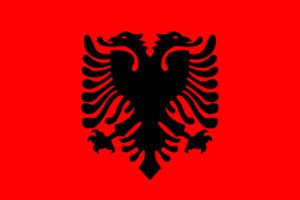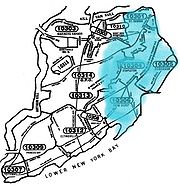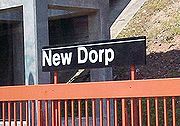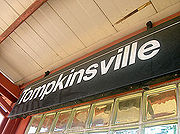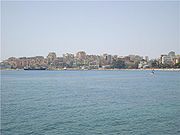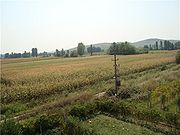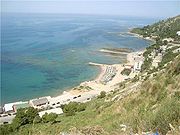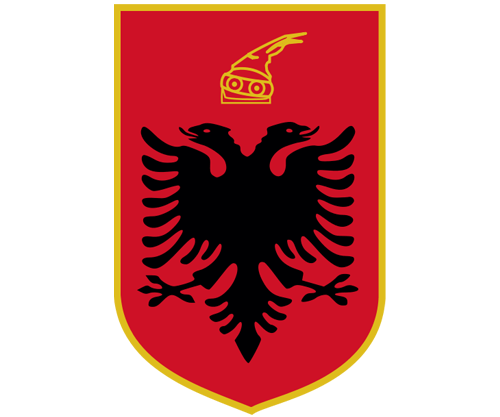From The Peopling of New York City
Contents |
Overview
Staten Island has a very large Albanian American community. In fact, Staten Island is the home to the most dense concentration of Albanian settlement in the New York City area. There are certain neighborhoods in Staten Island where more Albanians reside than others. These areas include Dongan Hills (10304), Tompkinsville (10301), New Dorp (10306), and Grant City (10305). The highest number of Albanians in Staten Island is on the East Shore.
Gëzojnë! (Enjoy!)
Demographics
Between the years 1931 and 1975, the total number of Albanians entering the United States was 2,438. After 1982, the official number of Albanians entering the United States has been as follows: 1983 (22); 1984(32); 1985 (45); 1986 (n/a); 1987 (62); 1988 (82) 1989 (69); 1990 (n/a); 1991 (141). The 1990 population census reports the number of people claiming at least one ancestor as Albania at 47,710, although the total population in the United States may range from 75,000 to 150,000 or more.
The 1990 census reveals that the largest number of Albanians live in New York City with a high concentration in the Bronx, followed by Massachusetts, Michigan, New Jersey, Illinois, California, Ohio, and Pennsylvania. Settlements of Albanians can be found in Chicago, Los Angeles, Denver, Detroit, New Orleans, Miami, Pittsburgh, and Washington, D.C. Some figures are as follows: New York 500,428, Michigan 150,343, Massachusetts 50,594, New Jersey 70,336, and Connecticut 37,200. In 2000, the Albanian community grew in New York City as follows: Bronx (7106), Brooklyn (6121), Manhattan (1700), Queens (5195), and Staten Island (4305). In all of New York City the Albanian Population was 24, 427. Albanians make up .9% of Staten Island, and .05% of New York City in 2000. Staten Island had a much denser Albanian population than any other borough.
Staten Island is the smallest borough but according to its size has a stunningly large amount of Albanians (4305) in 2005. The other boroughs had a small number of Albanians according to their size. Albanians made up .2% of Brooklyn and Queen population, .5% of Bronx population, .1% of Manhattan population, and .9% of Staten Island population. Staten Island has the densest population of Albanians.
Albanian Population as compared to other Ethnic Communities in New York (% Foreign born by borough 1970-2006)
- Albanian : 2.3%
- Italian : 8.7%
- Irish : 5.3%
- German : 3.2%
- Russian : 3.0%
- Polish : 2.7%
- English : 1.6%
- Greek : 1.0%
Number of Albanians located in selected states of the United States of America (1990 Census)
| States | Number of Albanians Residing | Percent |
|---|---|---|
| New York | 500,428 | 62% |
| Massachusetts | 50,594 | 6% |
| Michigan | 150,343 | 19% |
| New Jersey | 70,336 | 9% |
| Connecuit | 37,200 | 5% |
History
Albania is a country in Southeastern Europe. Albanians are the most recent group of Europeans to immigrate to the United States and their numbers have remained small. There were many reasons why Albanians left their homeland. Prior to World War I, Albanians migrated to America because of poor economic conditions or political concerns. However, many Albanians (between 20,000 and 30,000) who fled Albania for political reasons returned to Albania between 1919 and 1925. Many of these same Albanians then re-migrated to the United States, intending to remain permanently in America. Another wave immigrated after Albania came under Communist control in 1944. After the fall of communism, Albanians began entering the United States in increasing numbers between 1990 and 1991.
The People
Albanians immigrated to America for many reasons. One reason was economic problems the country was facing. There was a great deal of economic decay and families were struggling to survive. Many were losing money, including some whose money had been looted by the government. There was no control. Many Albanians wanted a better life. They wanted to become successful by working and making good money. Many wanted a chance to experience a good democracy while others wanted an education. These immigrants wanted better lives for their children and those generations after them. This is true of our interviewees: David, Alisa, and Susanna.
Religion
In Albania, three religions prevail. Albanians practice either Catholicism, Orthodox Christianity, or Islam. In the Albanian Constitution, it states that there is no official religion and that all people are free to practice the religion on their choice. However, many Albanians felt religious persecution in their country. Many could not get along with others that practiced a different religion. Many left Albania to come to American for religious freedom.
Ethnic Stages
"Ethnic Stages" refers to the locations on Staten Island or within the community on which people display their community membership and identity. This can mean churches, community centers, specialized stores with products from the home country, restaurants that serve the community's cuisine, or other sorts of institutions.
There are many Albanians on Staten Island. They densely populate the East and North Shore. There is an Albanian influence in many pizzerias such as Pronto Pizza, Bari’s Pizzeria, My Pizza Restaurant, and Chuck's Pizzeria and Restaurant. Chuck’s Pizzeria and Restaurant fits into the American culture because it offers popular American foods. It follows all American business rules and regulations. The owners and workers interact with all different types of customers and speak English to them. Although it conforms to the American culture because it is a pizzeria, it is an ethnic institution because it has Albanian speciality foods like bureks, kus, pleskavic, and qevapa. Also, the workers are all Albanian men and speak to each other in Albanian.
Readings
Hall, Derek. Albania and the Albanians. New York: St. Martin's Press, 1994.
Jacques, Edwin Albanians: An Ethnic History from Prehistoric Times to the Present. North Carolina: McFarland & Co Inc Pub , 2009.
Hayward, Rudall, and Ramai Hayward. The Young Albanians. Auckland: Hayward Historical Film Trust, 1999.
Knowlton, Mary. Albania. New York: Benchmark Books, 2005.
Allen, Louis. Changes in Social Organization: The Albanian Immigration to America. Cambridge, Massachusetts: Harvard University, 1950.
Kosic, Ankica, and Anna Triandafyllidou. Albanian Immigrants in Italy: Migration Plans, Coping Strategies and Identity Issues. London: Taylor & Francis, 2003.
King, Russel, Nicola Mai, and Stephanie Schwander-Sievers. The New Albanian Migration. Portland: Sussex Academic Press, 2005.
Nanos, Fatos Albania : Poverty Reduction Strategy Paper : Annual Progress Report. Washington D.C: International Monetary Fund, 2006.
Mazza, Donna. The Albanian. Washington: Fremantle Arts Centre Press, 2007.
McLain, Glenn. Albanian exposé; communism versus liberation for Albania.Quincy, Massachusetts: Premier Press, printers, 1952.
Further Research
• Kisha Ortodokse Autoqefale Shqiptare • Christianity -- Albania -- History. • Albania -- History. • EARLY MARRIAGE • FORCED MARRIAGE. • Albanian Americans • Albanians -- United States. • Orthodox Eastern Church, Albanian. • Albanians in New York (City) • Albanian Americans -- Cultural assimilation -- Massachusetts -- Boston.
Relevant Keywords:
• Albania • Immigrants • Double headed eagle • Shqiptarë • Dukagjin • Hardic • Orme • Raki • Red star • Coat of arms of Albania • Flag of Albania
Diten a Mir! (Have a Good Day!)
